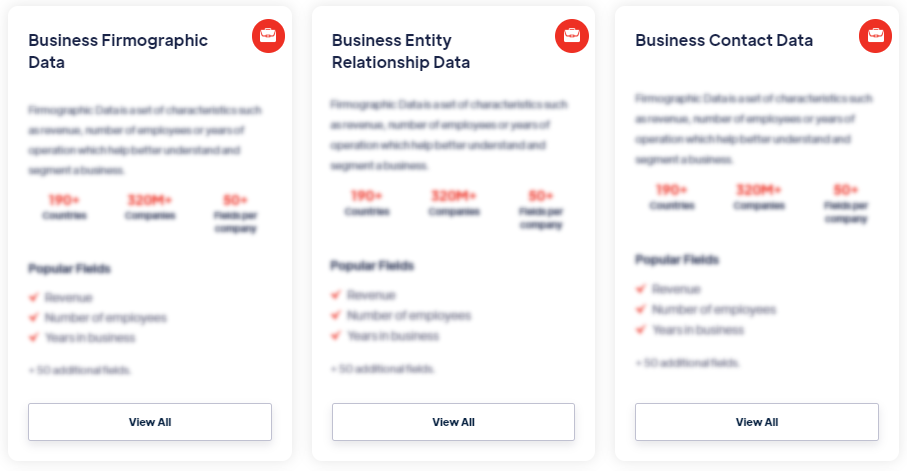Best
Cybersecurity Incident Data
Products
Cybersecurity Incident Data refers to information related to security breaches, incidents, or events that compromise the confidentiality, integrity, or availability of computer systems, networks, or data. It includes data on various types of incidents, such as unauthorized access, data breaches, malware infections, phishing attacks, denial of service (DoS) attacks, and insider threats. This data provides insights into the nature, impact, and consequences of cybersecurity incidents, enabling organizations to understand vulnerabilities, improve incident response, and strengthen their overall security posture. Read more
Our Data Integrations


Request Data Sample for
Cybersecurity Incident Data

Browse the Data Marketplace

Frequently Asked Questions
What is Cybersecurity Incident Data?
Cybersecurity Incident Data refers to
information related to security breaches, incidents, or events
that compromise the confidentiality, integrity, or availability
of computer systems, networks, or data. It includes data on
various types of incidents, such as unauthorized access, data
breaches, malware infections, phishing attacks, denial of
service (DoS) attacks, and insider threats. This data provides
insights into the nature, impact, and consequences of
cybersecurity incidents, enabling organizations to understand
vulnerabilities, improve incident response, and strengthen their
overall security posture.
What sources are commonly used to collect Cybersecurity Incident Data?
Common sources used to collect
Cybersecurity Incident Data include security incident logs,
intrusion detection systems (IDS), security information and
event management (SIEM) systems, antivirus software, network
monitoring tools, threat intelligence feeds, incident response
reports, and forensic analysis. Security incident logs record
information about security-related events, alerts, and
activities. IDS and SIEM systems monitor network traffic and
systems for signs of suspicious or malicious activities.
Antivirus software detects and reports on malware infections.
Network monitoring tools capture network traffic data for
analysis. Threat intelligence feeds provide real-time
information on emerging threats. Incident response reports
document details about security incidents and the actions taken.
Forensic analysis involves investigating and analyzing digital
evidence related to security incidents.
What are the key challenges in maintaining the quality and accuracy of Cybersecurity Incident Data?
Maintaining the quality and accuracy of
Cybersecurity Incident Data can be challenging due to several
factors. One key challenge is the underreporting or lack of
complete visibility into incidents. Not all incidents are
detected or reported, which may result in incomplete or biased
data. Additionally, incidents can be complex and multifaceted,
making it challenging to accurately capture all relevant
details. Another challenge is the timeliness of incident data.
Real-time or near real-time incident reporting is crucial for
effective incident response, but delays or gaps in reporting can
affect the accuracy and usefulness of the data. Data integrity
and authenticity are also significant challenges, as incidents
can involve tampering or attempts to manipulate data. Proper
documentation, data validation, and secure storage are essential
to ensure the quality and accuracy of incident data.
What privacy and compliance considerations should be taken
into account when handling Cybersecurity Incident
Data?
Handling Cybersecurity Incident Data involves important
privacy and compliance considerations. Organizations must comply
with applicable data protection and privacy regulations when
collecting, storing, and sharing incident data. Personally
identifiable information and sensitive data involved in
incidents should be handled securely and protected from
unauthorized access. Compliance with industry-specific
regulations and frameworks, such as the General Data Protection
Regulation (GDPR) or the Health Insurance Portability and
Accountability Act (HIPAA), may be necessary. Incident data
should be shared on a need-to-know basis, and appropriate data
anonymization or de-identification techniques should be applied
to protect privacy. Secure data transfer, encryption, and access
controls should be implemented to ensure confidentiality and
integrity. Compliance with incident reporting requirements, such
as those outlined by regulatory bodies or industry standards, is
also important.
What technologies or tools are available for analyzing and extracting insights from Cybersecurity Incident Data?
Various technologies and tools are available for
analyzing and extracting insights from Cybersecurity Incident
Data. SIEM systems provide real-time monitoring, correlation,
and analysis of security events and incidents. Security
orchestration, automation, and response (SOAR) platforms
automate incident response processes and facilitate analysis.
Forensic analysis tools assist in investigating security
incidents and analyzing digital evidence. Data visualization
tools help in presenting incident data in a meaningful and
actionable way, enabling analysts to identify patterns, trends,
and indicators of compromise. Machine learning and AI techniques
can be used to analyze large volumes of incident data, detect
anomalies, and identify potential threats. Threat intelligence
platforms and services provide additional context and enrichment
to incident data, helping organizations understand the threat
landscape and take appropriate actions.
What are the use cases for Cybersecurity Incident Data?
Cybersecurity Incident Data has several
use cases within organizations and the broader security
community. It plays a crucial role in incident response,
enabling organizations to detect, contain, and remediate
security incidents promptly. Incident data aids in post-incident
analysis and forensics, helping to understand the root causes,
impact, and extent of incidents. It supports incident trend
analysis and reporting, providing insights into the frequency,
nature, and severity of different types of incidents. Incident
data contributes to the development of incident response
playbooks, procedures, and best practices. It also plays a vital
role in threat intelligence sharing, allowing organizations to
learn from each other's experiences and collaborate in
mitigating common threats. Incident data can be used for
regulatory reporting and compliance, ensuring organizations meet
incident reporting requirements mandated by regulatory bodies.
Additionally, incident data supports security analytics,
enabling the identification of patterns, trends, and indicators
of compromise to strengthen overall cybersecurity defenses.
What other datasets are similar to Cybersecurity Incident
Data?
Datasets similar to Cybersecurity Incident Data include
security event data, log data, network traffic data,
vulnerability data, threat intelligence data, and malware
analysis data. Security event data captures information about
security-related events, alerts, or anomalies detected by
security systems. Log data provides records of activities,
configurations, and system events. Network traffic data provides
insights into network-level activities and communications.
Vulnerability data includes information about known
vulnerabilities and associated risks. Threat intelligence data
provides real-time information on emerging threats and
indicators of compromise. Malware analysis data includes data on
the behavior, characteristics, and signatures of malicious
software. These datasets share similarities with Cybersecurity
Incident Data in terms of their focus on security-related
events, incidents, vulnerabilities, threats, and malicious
activities.
